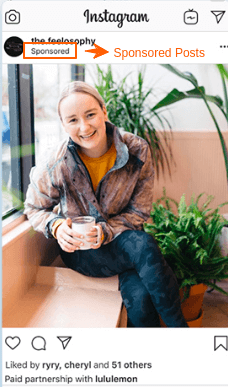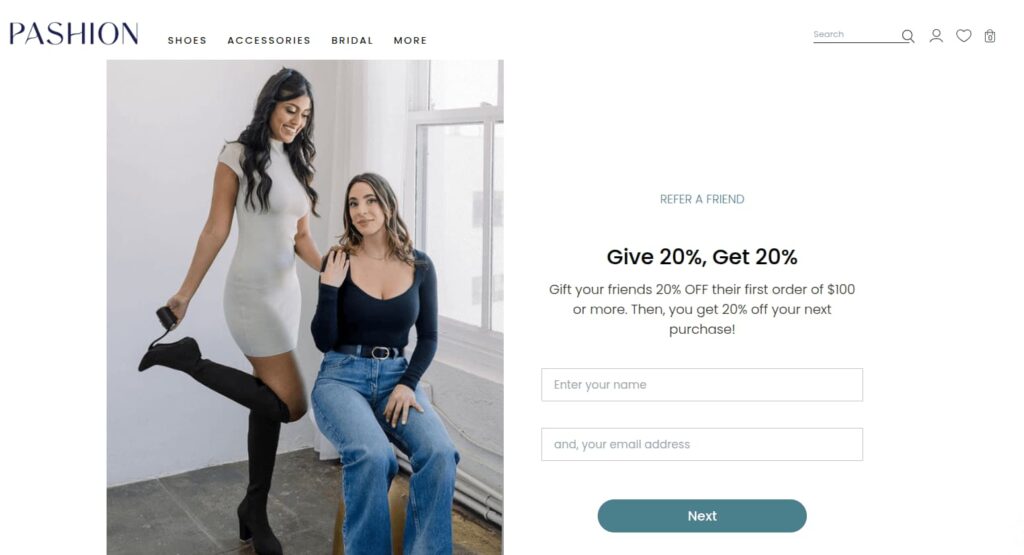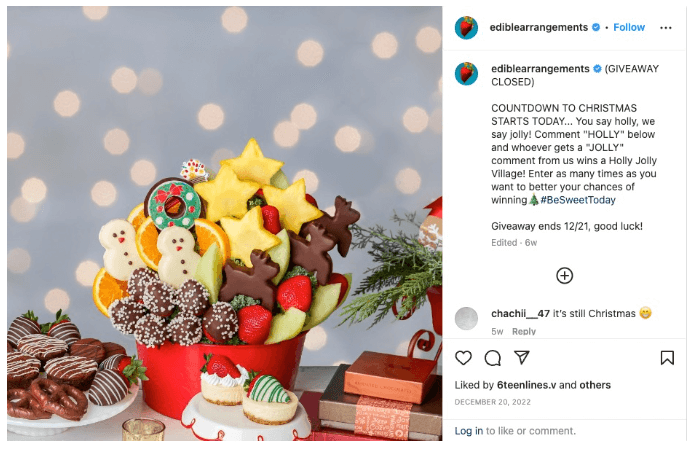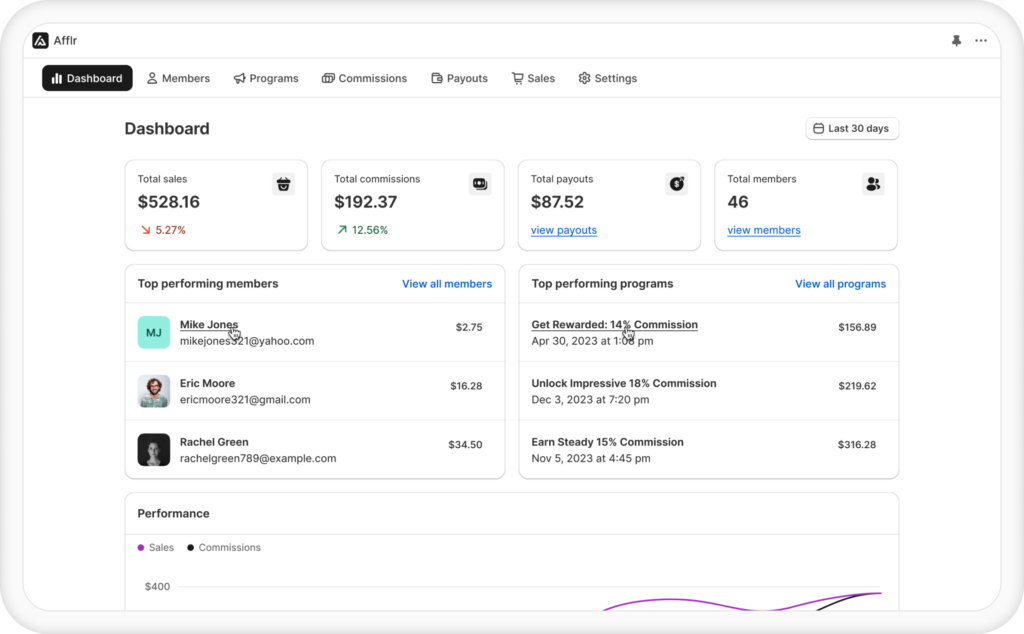A brand needs to be represented authentically to stand out in the market. Thus, build influencer partnerships with voices trusted by people.
Besides supporting your influencer marketing strategy and driving results, these social media influencer partnerships also enhance your brand image and credibility among potential customers.
Ideally, strong influencer relationship management is the key to sustainable growth. Therefore, for successful influencer brand partnerships, you need trust, goal alignment, and mutual benefit.
This blog is the ultimate guide that teaches you everything to master influencer partnerships. We’ve explored everything from identifying the right social media influencers to influencer outreach strategies and best practices to follow.
Launch Your Influencer Program in Minutes with Afflr. Onboard Creators, Track Results, and Grow Your Sales
What are Influencer Partnerships?
Influencer partnerships mean brands teaming up with popular creators or social media influencers to promote products through authentic content. Subsequently, they are offered performance-based rewards based on the campaign results.
The success of the collaborations of influencer and brand depends on the popularity these creators have online. Additionally, you can leverage the trust their audience has in their word-of-mouth promotions.
This is one of the recent and growing digital marketing strategies. In fact, 75% of people trust referrals they see on social media.
You can build strong influencer relations through trust in content, mutual respect, fair compensation, and clear communication.
What are the Benefits of Partnering with Influencers?
The influencer partnership benefits for your e-commerce store are:
- Instant credibility with new audiences: Building brand credibility takes time. However, with influencer paid partnerships, the trust that audiences have in influencers will spill over to the brand. Hence, the trust-building aspect is accelerated.
- Higher engagement rates than traditional ads: The impact of Influencer marketing and partnerships on brand awareness is very high. You can reach a wide audience with traditional ads. However, the conversion rate will be low. With social media marketing, you can target a niche audience.
- More authentic product demonstrations: With user-generated content, the tutorials, demos, or reviews through influencer marketing are seen as genuine. Therefore, you can garner more trust among the audience.
- Higher ROI on budget: Social media influencers often deliver 11x higher ROI than traditional digital campaigns. Therefore, you can structure Influencer monetization models to create a win-win situation.
- Test new markets with minimal risk: Brand partnerships with influencers have low upfront costs. Therefore, they are best for new businesses or when launching new products. Hence, social media can be used as a ground to test.
What are the Types of Influencer Partnerships?
Here are the best types of influencer partnerships for successful brand ambassador programs and campaigns:
1. Affiliate Partnerships
In affiliate marketing, you can pay influencers a commission for each sale they generate through their unique affiliate tracking link. This is effective because you only pay when you make money.
For example, you might give them 10% of every sale their followers make using their code “INFLUENCER10”.
2. Sponsored Posts
Partnership with influencers can help create content featuring your product. Influencer sponsorships usually involve a flat fee. Consequently, this gives you quick exposure to the audience.
Followers already trust their recommendations. Therefore, this is best when you only want visibility for your brand or products.
Usually, the hashtags #sponsored or #paidad are added to sponsored posts.

3. Customer Referral
You can convert your customers into your brand advocates. Unlike other brand collaborations, here, you will work with real customers instead of popular social media influencers.
This is ideally referral marketing, where for every referral your customers bring, they will be rewarded.

4. Content Creation Deals
You can hire influencers to create photos or videos that you can use on your website and social media.
Firstly, you will receive professional-quality content featuring real people using your products. Therefore, you can showcase the authenticity of your brand easily.
5. Product Seeding
You can send free products to influencers, hoping they’ll mention them naturally. Hence, there is no monetary benefit involved in these brand partnerships with influencers.
There is no guarantee they’ll post. However, when they do, it will come across as authentic. Unlike sponsored posts, there is no need to mention any hashtags with such posts.
6. Takeovers
You can give temporary control of your social media accounts for this type of brand partnership to influencers.
Along with bringing your audience to your channels, this adds fresh energy to your content.
These takeovers can involve Instagram Live, X Q&A, or even YouTube vlogs of behind-the-scenes scenarios.
7. Giveaways and Contests
With the partnership with influencers, you can give away your products to their followers. This is unlike other influencer endorsement deals. In fact, this allows followers to use your product.
Thus, you can organically increase your follower count, engagement, and mentions. In addition, this can also increase your brand visibility and conversion.

The most successful influencer campaigns combine multiple partnership types for maximum impact. You can explore real-world influencer partnership examples and case studies to understand the different strategies used by brands.
Create flash sale coupons using the Discount Rules Pro plugin to attract customers and boost sales.
How to Identify the Right Influencers for Brand Partnerships?
Here are the steps to identify the right influencers for brand partnerships:
Step 1: Decide what size influencer fits your goals
Micro-influencer partnerships often give you more engagement due to their dedicated audience. However, celebrity influencers will give you better reach.
Therefore, finalize your budget and campaign goal before choosing the type of influencer to work with.
Related Reading: Micro vs. Macro vs. Nano Influencers.
Step 2: Choose your influencer platforms
Instagram influencer marketing partnerships are best for visual products, while TikTok marketing works better to reach younger shoppers. Firstly, figure out where your customer’s volume is high.
Step 3: Look for content that matches your brand tone
Some influencers will create funny content, while others will create aesthetically pleasing content. Therefore, you should choose someone whose style aligns with your products.
Step 4: Check their audience demographics
Using influencer recruitment tools, you can see if an influencer’s followers match your target customers. Since there’s no point partnering with someone whose audience can’t or won’t buy your products.
Step 5: Check Influencer analytics
There are influencer marketing platforms that show important metrics like engagement rates, audience type, and past performance. Ultimately, consider them over follower count.
Remember, to recruit affiliate partners, you need to consider quality over quantity. Therefore, only collaborate with those who perfectly align with your brand vision.
Tips to Reach Out to Influencers for Partnership
Establishing paid partnerships with influencers requires a strategic approach. Here are tips to reach out to influencers:
- Engage with them. Firstly, engage with their posts before you reach out for paid influencer partnerships. Thus, you can show that you genuinely care about their content.
- Now, send your first message. Your message should be short and friendly. Ideally, influencers get a lot of DMs. Hence, try to catch their attention quickly. Therefore, clearly mention who you are and why you’re reaching out.
- Make it personal. Don’t copy-paste influencer outreach messages. Firstly, mention their name. Furthermore, add something specific you loved about their content.
- Focus on benefits. You don’t just talk about your brand. Share what’s in it for them. In fact, go beyond money and offer creative freedom, free products, or exposure through partnerships between the brand with influencers.
- Pick the right channel. To message an influencer for a brand for collaboration, first use DMs for a casual start. Following that, use affiliate emails for negotiating contracts for brand partnerships for influencers. This combo works great.
- Share a media kit. Apart from a simple PDF with product info, share banners, and other marketing material. Thus, they can easily promote affiliate links.
- Regular Communication. Consistent and quick replies show you care. As a result, you can build trust and nurture influencer engagement.
- Track their performance. Use tracking tools to monitor the performance of the influencers. This can help optimize your campaign.
How to Track and Manage Influencer Collaborations?
Here are some tips and strategies to track and manage influencer collaborations
Using Tools to Track Influencer Campaigns
Measuring the ROI of influencer marketing and partnerships with a brand requires setting up proper affiliate tracking tools.
An influencer marketing app like Afflr offers real-time tracking of your influencers’ activity and automates conversion and commission approval.
Manual Tracking of Influencer Marketing
Even without tools, you can track influencer marketing performance by manually monitoring engagement. These metrics can include likes, comments, shares, etc.
Moreover, you can test different formats and experiment with various influencers to see who has the most impact. This hands-on approach is time-consuming. However, helps refine your future influencer marketing strategies.
While you track your influencer performance, you can concentrate on the main influencer marketing KPI like click-through rate[CTR], clicks per sale, etc.
Future Trends in Influencer Marketing & Partnerships
- AI & Automation in Influencer Affiliate Marketing
Influencer marketing will increasingly use AI tools. For example, you can use AI to match brands with the perfect creators. Thus, the process will be more efficient and effective. - Performance-Based Influencer Brand Collaborations
Many partnerships of brands are moving toward performance-based models. Consequently, you’ll pay more for actual results rather than just content creation. - Emerging Social Media Platforms
Influencer sponsorships are becoming huge. Therefore, we can expect more complex campaigns that include multiple platforms and content formats. - Live Shopping
The future of influencer marketing in digital advertising includes more seamless live shopping experiences. Thus, influencers will not only market but also sell your products.
Scale Smarter with Afflr. Create Branded Affiliate Links, Monitor Conversions, and Pay Commissions – All with Afflr.
Conclusion
Many of the best influencer partnerships will be long-term relationships. Consequently, they will help build a loyal community of brand advocates who genuinely love your products.
However, to make this happen, understanding customer trust and social media trends is important.
This guide has explained the impact of influencer partnerships on brand awareness and revenue. Thus, through our recommended steps, you can find the right influencers and develop marketing campaigns with effective performance monitoring.
As a result, you can effortlessly build your own influencer marketing strategies to drive growth.
Further Reading
- Ultimate Guide: TikTok Affiliate Marketing
- Complete Guide: Facebook Affiliate Marketing
- Quick Start Guide: Affiliate Marketing for Beginners
- Ultimate Guide: Affiliate Management
Frequently Asked Questions
The most popular type of influencer partnership is sponsored content. Brands get dedicated posts where they pay for product features. Thus, brands can achieve better results by mixing sponsored content with affiliate partnerships.
To manage influencer partnerships, you require a detailed contract, clear communication, and continuous performance tracking before paying the commission on time.
Through influencer collaboration, brands team up with relevant content creators to promote their products. As a result, the brands benefit from market reach while influencers get compensation.
The influencer marketing model typically relies on the 3 R’s: Reach, Relevance, and Resonance. Consequently, these three elements decide whether an influencer marketing campaign will succeed or fail.
Influencer marketing helps raise brand awareness by introducing the products to their followers. From these metrics, brands can get higher visibility and appear more genuine.
You can approach influencers by first engaging with their content. Then, message them through DMs or email. You can communicate your requirements, explain their benefits, and onboard affiliate partners effortlessly.
